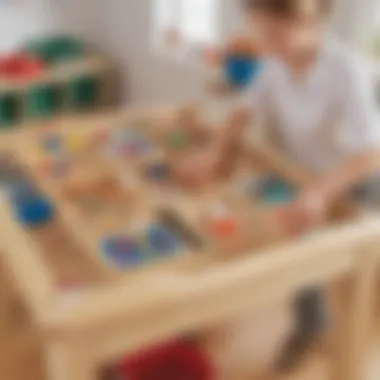Innovative Sensory Table Ideas for Young Science Enthusiasts


Intro
Establishing a sensual understanding of our world can enrich a child's education. Sensory tables play a crucial role in this process, providing hands-on experiences and stimulating young minds. By engaging children aged six to twelve with innovative sensory table ideas, we can effectively spark their interest in science. These activities not only entertain but also impart valuable lessons.
In this article, we delve into unique sensory table concepts. We will explore science fun facts, showcase relevant experiments, and provide practical guidance for implementation. The ultimate goal is to create environments where exploration and learning coalesce seamlessly.
Science Fun Facts
Integrating fun facts into sensory activities can boost the engagement level significantly. Here are a few intriguing trivia and facts that can elevate your sensory table projects:
- Did you know? Water can exist in three states: solid, liquid, and gas. This can be illustrated using ice, water, and steam experiments.
- Curious about bubbles? The largest bubble ever made measured 1.3 meters in diameter, showcasing the vast possibilities of surface tension.
- Colorful chemistry: Mixing vinegar and baking soda can create a fizzy reaction, illustrating basic chemical processes for kids.
"Curiosity about the natural world is the essence of human existence."
— Dr. Carl Sagan
Incorporating these fun facts can instill a sense of wonder and inquiry. Children are naturally curious, and presenting them with engaging tidbits can stimulate new questions and exploration.
Discover the Wonders of Science
Educational experiences through sensory play can extend beyond simple touch. Each sensory table can represent a unique scientific concept, providing real-life applications.
- Exploring Various Scientific Concepts:
- Interactive Learning Tools:
- Educational Videos and Animations: Integrate short clips that illustrate concepts related to activities at the table. You can find valuable videos on platforms like YouTube where science meets fun.
- Biology: Use natural items like leaves and rocks to teach children about ecosystems.
- Physics: Introduce weight and balance with different sized stones or blocks.
- Websites such as Britannica and Khan Academy offer further resources aligned with sensory exploration.
Science Experiment Showcase
To make sensory tables successful, integrating simple science experiments can create excitement. Here are a few fun activities:
Engaging Experiments:
- Magic Milk: Use food coloring and milk to explore chemical reactions.
- Homemade Oobleck: Mix cornstarch and water for a non-Newtonian fluid experience, demonstrating properties of solids and liquids.
Step-by-Step Instructions:
- For Magic Milk, pour milk into a dish and add drops of food coloring. Then, dip a cotton swab in dish soap and touch the milk. Watch the colors swirl!
- For Oobleck, combine two cups of cornstarch with one cup of water, then let kids explore its properties.
Materials List:
- Milk, food coloring, dish soap for the Magic Milk experiment.
- Cornstarch, water for the Oobleck.
Safety Tips and Precautions:
- Supervise children closely during all experiments and use non-toxic materials.
- Encourage wearing aprons to keep clothes clean.
By employing these engaging methods, children engage with scientific principles in an enjoyable way. They can learn by doing, which is often the most effective method.
Prolusion to Sensory Play
Sensory play refers to activities that involve the use of one or more of the senses. This type of play is crucial for children, especially those aged six to twelve. Engaging their senses enhances their learning experience. Children explore the world through touch, sight, sound, smell, and taste. In doing so, they naturally develop important skills.
Defining Sensory Play
Defining sensory play involves more than just engaging in activities. It includes exploring various materials and environments. Sensory play is characterized by using resources that stimulate a child’s senses. These may include sand, water, plants, or even various textures like foam and clay. It allows children to investigate and discover. This investigative approach can nurture creativity and imagination.
The Importance for Child Development
The importance of sensory play is undeniable. It plays a significant role in cognitive, emotional, and physical development. Through sensory experiences, children can:
- Enhance Fine Motor Skills: Manipulating different textures improves coordination.
- Boost Cognitive Development: Exploring materials allows for problem-solving skills to flourish.
- Foster Social Skills: Engaging in group activities encourages communication and cooperation.
- Develop Emotional Skills: Children learn to express feelings through sensory interaction.


Research shows that sensory play is vital for emotional regulation and overall development in children.
Key Elements of Sensory Tables
Creating an engaging sensory table requires understanding the key components that will optimize both enjoyment and educational value. In this section, important elements are identified, while also exploring how they can benefit the development of young science enthusiasts.
Understanding Sensory Materials
Sensory materials are the cornerstone of any effective sensory table. These materials engage children through touch, sight, and sometimes sound. Understanding the types of materials available can greatly enhance the sensory experience.
Different materials serve different purposes. For example, dry materials like rice or sand provide tactile experiences that encourage exploration and creativity. Wet materials, such as water mixed with various objects or gelatin experiments, can demonstrate properties of liquids and solids. Combining textures offers children diverse ways to engage with the table.
When selecting sensory materials, factors like safety, ease of clean-up, and sensory benefits should be considered. Often, the best experiences come from materials that stimulate multiple senses at once. For instance, introducing scents or colors can elevate the engagement and make the experience more memorable.
Choosing the Right Table
The selection of the sensory table is also crucial. The right table will offer a space that encourages exploration and is suitable for the intended activities. There are several factors to consider when picking a table for sensory play:
- Size: The table should be large enough to accommodate multiple children without feeling crowded. This allows for collaborative play and encourages social interactions.
- Material: Opt for tables made of durable materials that can withstand spills and rough handling. Plastic or treated wood is often a good choice.
- Accessibility: The table should be at a height that is comfortable for children. This can help promote independent play and creativity.
- Features: Consider tables with compartments or areas for different activities. Such designs can help organize materials and make clean-up easier.
A well-chosen table not only serves a functional purpose but also can inspire creativity and focus in learning. Ultimately, the right sensory table can transform a simple play area into a dynamic learning environment that fosters curiosity and scientific exploration.
Theme-Based Sensory Table Ideas
Theme-based sensory tables serve as an effective tool to ignite children's curiosity. Themed activities provide context and meaning, making learning engaging. Each theme caters to various interests, enhancing imaginative play and exploration. By integrating specific, relatable themes, children can connect concepts from the sensory play to real-world experiences. This integration fosters deeper understanding and appreciation for different subjects.
Nature Exploration Themes
Nature exploration themes are designed to inspire wonder and fascination about the natural world. These activities help children understand ecology and the importance of the environment through direct interaction with materials that mimic nature.
Garden Delights
Garden Delights involves creating a mini garden setup using soil, plants, and insects or similar representations. This theme promotes kinesthetic learning through tactile engagement with natural elements. By digging, planting, and watering, children learn about plant growth and ecosystems.
The key characteristic of Garden Delights is its ability to demonstrate ecological processes in a hands-on manner. It is a beneficial choice because it offers children a sensory experience that can teach them about responsibility in caring for living things. However, a disadvantage may be the messiness involved with soil and water, necessitating proper oversight and cleanup considerations.
Seashell Discovery
Seashell Discovery allows children to explore the diverse textures and shapes of shells. This theme can enhance learning about marine biology and coastal ecosystems. Children can engage in sorting and categorizing a variety of seashells, which promotes skills in classification.
The unique feature of Seashell Discovery is its emphasis on tactile and auditory stimulation, as children can often hear subtle sounds when seashells are manipulated. This theme is popular as it connects children to oceanic environments, but it may have limitations, such as requiring careful handling to avoid breakage.
Seasonal Themes
Seasonal themes provide changing contexts throughout the year, keeping sensory play fresh and relevant. These themes allow children to experience the different elements associated with various times of the year.
Winter Wonderland
Winter Wonderland creates a sensory experience that replicates the sights and sounds of winter. Options include using fake snow, ice cubes, or winter-themed objects. This helps children explore concepts related to seasons, temperature, and environmental changes.
The key characteristic of Winter Wonderland is its visual appeal, which can attract children's attention effectively. It is a beneficial choice as it allows discussions about winter animals and weather patterns. However, a disadvantage is that some components may pose safety concerns, especially if small parts are included.
Fall Harvest
Fall Harvest focuses on seasonal produce such as pumpkins, corn, and leaves. This theme encourages learning about agricultural cycles, nutrition, and nature's bounty. Children can engage in sorting and arranging these materials in various sensory activities.
A key characteristic of Fall Harvest is its rich textures and vivid colors. It is beneficial as it introduces children to food sources and environmental awareness. On the downside, the availability of fresh produce may be a limitation, particularly in off-seasons. This can make recreating the experience challenging without access to appropriate materials.
Science Experiment Themes
Science experiment themes allow for more hands-on experimentation and encourage children to ask questions while finding their answers. These themes blend sensory play with fundamental scientific principles, leading to a more comprehensive educational experience.
Chemistry Reactions


Chemistry Reactions engage children in simple yet fascinating experiments. Using everyday materials, children can observe changes that occur in mixtures, such as vinegar and baking soda reactions. This theme deepens understanding of cause-and-effect relationships.
The key characteristic of Chemistry Reactions is their instant feedback through visible changes, making concepts of reactions accessible and memorable for children. It is a beneficial choice to cultivate excitement around science. However, safety is important, as certain materials require careful handling to prevent misunderstandings.
Physics in Action
Physics in Action focuses on exploring concepts such as gravity, motion, and force. Children can experiment with ramps, balls, and weights to see physics principles in motion. This theme promotes critical thinking as children test various scenarios.
The unique feature of Physics in Action is how it encourages children to engage in trial and error while observing results firsthand. It is beneficial as it reinforces scientific concepts in a practical way. But it also requires adult supervision to guide experiments correctly, especially when working with more complex setups.
Creative Material Ideas
Creative material ideas play an essential role in developing effective sensory tables. They shape the experience children have during sensory play, engaging their curiosity and deepening their understanding of various scientific principles. The right materials can inspire little minds to explore, ask questions, and discover through play while enhancing tactile experiences. Thus, focusing on inspiring and educational materials is crucial for optimizing the learning potential of sensory tables.
When selecting materials, it is important to consider the texture, safety, and educational value of what is used. Depending on the theme, using both dry and wet materials can create diverse sensory experiences. These materials should stimulate the senses and provide opportunities for kids to experiment and learn, contributing to their overall developmental journey.
Dry Materials
Dry materials present a variety of unique characteristics that can enhance sensory exploration. Children often enjoy manipulating these materials, allowing them to engage their senses through touch, sight, and sound.
Rice and Grains
Rice and grains are a popular choice for sensory tables. Their fine grains allow for a smooth tactile experience. They can easily be scooped and poured, providing opportunities to explore concepts such as measurement and volume. Additionally, rice can be dyed to match different themes, making it versatile.
A unique feature of rice is its ability to provide a calming sensory experience. Children may find the sensation of sifting and running their fingers through rice soothing. On the downside, cleanup can be challenging as smaller grains are easy to scatter.
Sand and Peat
Sand and peat are other dry materials frequently used in sensory tables. They enable children to engage in imaginative play while also exploring important scientific concepts like erosion and layering. Sand is particularly beneficial for constructing and molding, sparking creativity through building and shaping. Peat, being slightly spongy, provides a unique texture. Both materials facilitate exploration of wet and dry interactions. A disadvantage could be the potential mess created, as they can easily spread outside designated areas.
Wet Materials
Wet materials can significantly enrich sensory play by adding elements of transformation and gravity. They tend to create dynamic environments that encourage active exploration and hypothesis testing among children.
Water with Objects
Water with various objects encourages children to experiment with buoyancy and gravity. When incorporating items like rubber ducks or small balls, children observe what floats or sinks, stimulating their curiosity. The transparency of water allows for visual exploration of submerged objects. A downside can be the potential for mess, but with proper supervision, the learning outcomes can outweigh this.
Gelatin Experiments
Gelatin experiments offer a fascinating tactile experience as kids can manipulate the wobbly substance while also learning about states of matter. These experiments can introduce ideas about temperature by discussing how gelatin begins to set when cool. Kids enjoy digging and unearthing hidden objects within the gelatin, igniting a treasure hunt mentality. While gelatin provides a unique play experience, it's also essential to recognize that it can be slippery and difficult to control, leading to extra cleanup tasks. Proper guidance can help mitigate this.
Sensory Bottles and Bags
Sensory bottles and bags are compelling tools in sensory play. They provide an opportunity for kids to visually engage with color, texture, and motion in a contained environment. By filling bottles or bags with liquid, glitter, beads, or small toys, children can view and manipulate these elements safely. These items promote exploration, and they can be easily customized to fit various themes, thus increasing their appeal and educational value. They require minimal cleanup, but the benefits of tactile engagement are significant. They can be a great option for quieter situations or for calming purposes.
Integrating diverse creative materials in sensory tables unlocks various learning pathways for children, combining play with essential educational concepts.
Integrating Learning with Sensory Play
Integrating learning with sensory play enriches the experiences children have while exploring their environments. Sensory tables can become crucial tools in bridging play and education. This approach encourages children to engage actively rather than passively absorb information. The simplicity of materials often belies the richness of concepts being taught. The multi-sensory experience can enhance understanding and retention of scientific principles.
Incorporating Scientific Concepts
Simple Physics
Simple physics ideas are foundational for understanding the world. Concepts like buoyancy, gravity, and motion can be taught effectively through sensory play. For example, filling a sensory table with water and various objects can illustrate what sinks or floats. Children can experiment with different shapes and weights, engaging them in direct observation and inquiry.
This method appeals to children’s natural instincts to explore. The tactile engagement reinforces their understanding in a memorable way. However, careful supervision is important when water is involved to prevent accidents. The hands-on opportunity allows children to apply basic physics principles in a fun context, creating lasting memories tied to learning.
Basic Chemistry
Basic chemistry can also be an exciting aspect to integrate into sensory play. Simple reactions, like combining vinegar and baking soda, offer visible and immediate results. Children observe bubbling reactions, helping them grasp fundamental chemical interactions.


Moreover, combining safe kitchen materials allows learners to witness changes that occur when substances mix. This exploration instills a sense of curiosity and wonder about the science behind everyday phenomena. While safe, adults must always oversee these activities to ensure security. In essence, introducing basic chemistry through sensory tables makes the subject accessible and engaging.
Encouraging Critical Thinking
Critical thinking is pivotal in a child's learning journey. Through sensory play, children often ask questions, hypothesize, and test their ideas. This active involvement encourages them to think deeply about what they are doing.
In summary, integrating learning with sensory play not only enhances educational experiences but also fosters a deeper connection to scientific concepts. The hands-on approach provides an effective platform for children to grasp complex ideas in an intuitive manner. As a result, caregivers can cultivate an environment where learning is intertwined with joyful exploration.
Safety Considerations
Creating engaging sensory tables is a wonderful way to spark curiosity and imagination in children. However, the enjoyment and educational value of these activities are closely linked to safety. It is essential to prioritize safety considerations to not only protect the children but also ensure a positive experience while they explore. Unsupervised play with materials can lead to accidents or injuries, particularly for younger children. Thus, understanding and implementing safety measures is not just beneficial; it is vital.
Choosing Non-Toxic Materials
When assembling a sensory table, selecting non-toxic materials is paramount. Children have a tendency to put things in their mouths. Hence, every material should be age-appropriate and safe. Non-toxic substances should be prioritized to prevent any potential health risks due to ingestion or skin contact. Here are some recommended materials:
- Natural items: Opt for things like leaves, flowers, and pebbles. These items are generally safe and can engage children’s senses without risk.
- Food products: Items like dry beans, rice, or even cornstarch are safe and provide varied textures. Always check for allergies beforehand.
- Commercial sensory products: Brands like Play-Doh or kinetic sand are designed with safety in mind and can enhance the sensory experience while minimizing risk.
Using these considerations, parents and caregivers can create a sensory environment where discovery marries safety.
Supervision and Guidelines
Supervision plays an essential role in maintaining safety during sensory play. Adults should actively oversee the activities to ensure that safety guidelines are always met. Supervisors can identify hazards, provide assistance, or intervene if play becomes dangerous. Here are some basic guidelines to follow:
- Set clear boundaries: Establish where the sensory table is located and what areas are off-limits.
- Limit the number of children: Organize children in manageable groups to avoid overcrowding and ensure everyone can engage safely.
- Monitor interactions: Children may need guidance on how to share materials or take turns. Assisting with these social skills fosters a harmonious environment.
- Educate about material use: Teach children how to use materials properly and what to avoid, drawing attention to any choking hazards.
Ensuring safety during sensory table activities enhances the overall fun while allowing children to explore freely.
By focusing on these key safety considerations, everyone can enjoy the wonders of sensory play without unnecessary risk.
Examples of Successful Sensory Tables
Selecting effective sensory tables can create spaces where children can explore freely and learn hands-on. These tables serve as more than just play areas; they can become centers for inquiry, fostering both their curiosity and problem-solving skills. By examining successful examples of sensory tables, educators and caregivers can understand the design principles and materials that promote enriching experiences for young science enthusiasts.
Community Learning Spaces
Community learning spaces play a significant role in encouraging collaborative exploration. In these environments, children have the opportunity to interact with their peers, which enhances social skills and shared learning experiences. A successful community sensory table might integrate local themes. For example, a table themed around the local ecosystem could feature soil, leaves, and small animals or insects to study.
Key considerations for creating these tables include:
- Inclusivity: Ensure materials cater to various skill levels and interests.
- Adaptability: Design tables that can easily change themes or materials based on seasons or community events.
- Observation Opportunities: Place magnifying glasses or simple tools to encourage observation.
Setting up a sensory table within a community space not only stimulates learning but also fosters a sense of belonging. Children engage with science concepts in practical ways and see the relevance of these concepts to their environment.
Home-based Sensory Areas
Home-based sensory areas offer families the chance to create intimate and controlled learning environments. Parents and caregivers can tailor these spaces to fit their children's interests and developmental stages. A simple yet effective example includes a table filled with different textured materials, like cotton balls, sand, and water beads. This can engage children in sensory exploration while introducing basic scientific principles of texture and density.
Developing home sensory areas requires careful thought about materials and accessibility. Consider the following:
- Safety: Always choose non-toxic and safe materials.
- Variety: Rotate the contents frequently to keep children curious and engaged.
- Engagement: Encourage family participation to make the experience enjoyable.
By incorporating science-related tasks in an engaging way, children can learn about chemical reactions by mixing vinegar and baking soda, or they can explore the concept of floating and sinking with different objects in water. A home sensory table thus not only serves as a platform for exploration but also strengthens bonds within families through shared activities.
"Sensory tables, whether in homes or community spaces, allow children to understand their world better through touch, sight, and exploration."
Ending
Sensory tables represent a powerful tool in the developmental landscape of young children. The insights shared throughout this article demonstrate the critical role these tables play in fostering curiosity, creativity, and foundational knowledge in science. By engaging with various materials and hands-on activities, children not only learn through exploration but also enhance their sensory integration.
Emphasizing the educational aspects of sensory tables can significantly enrich children’s learning experiences. When designed thoughtfully, these tables offer platforms for observation, experimentation, and discovery. They serve as a bridge connecting playful experiences to scientific concepts, allowing children to grasp complex ideas through tangible interaction.
Moreover, parents and educators benefit from integrating sensory experiences into regular learning frameworks. It creates dynamic environments where children feel empowered to question, hypothesize, and find answers independently. This investment in sensory play encourages lifelong learning habits and a deeper appreciation of the natural world.
As sensory tables evolve, the need for innovation in materials and approaches becomes increasingly pertinent. Groups working with children can adapt to diverse themes and create customized experiences tailored to specific interests and educational goals. Ultimately, the engagement fostered through sensory exploration not only cultivates academic skills but also nurtures emotional and social development.
"Sensory play is not just an activity; it is an essential part of growing up."
In summary, the successful implementation of sensory tables can offer profound benefits that extend well beyond the immediate learning objectives. They promote a culture of curiosity and exploration, making them indispensable in early science education.







